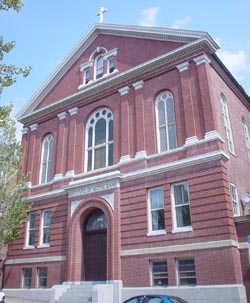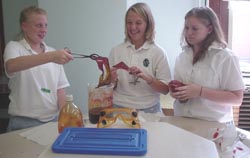| Maryland Newsline |
| Home Page |
Politics
|
| Catholic School Offers Girls
More Than Education
Capital News Service Friday, Oct. 28, 2005 BALTIMORE - The buckled and worn slate steps on the staircase that rises through the Institute of Notre Dame are an emotional and physical anchor for this small, Catholic all-girls high school that has persistently remained in the same downtown location since 1847. Almost 80 years old, the dark steps are deeply curved from years of use, but like the school itself are still sturdy and safe and continue to serve. "IND is the best-kept secret in East Baltimore," said Terry Grant, chairman of the school's science department. "We do things the big (public) schools can't do, and we have students who are willing to go the extra mile."
Among the school's graduates are two of the most powerful women in Congress. Yet despite its permanence and powerful alumnae, the venerable Institute of Notre Dame struggles for recognition alongside Baltimore's posh prep schools. In fact, the institute is commonly confused with the considerably more expensive suburban Notre Dame Prep in Towson, known as Notre Dame "in the valley" to contrast with the institute, known affectionately as Notre Dame "in the alley." Both are run by the School Sisters of Notre Dame. The Institute of Notre Dame has 158 years of consecutive education at its location, said school President Sister Mary Fitzgerald. Since it was built 10 years after the school's founding, seven additions have been made to the building. While many of the city's prep schools, including Notre Dame Prep, moved out of the city in the 1960s, the Institute of Notre Dame has remained, hard by some of Baltimore's poorest neighborhoods. "IND made a deliberate choice to remain in the city because we feel there are already services in the county, and we do have a commitment to the city of Baltimore," Fitzgerald said. "We feel we're an anchor in the city and have been for almost 159 years." The sense of permanence isn't lost on the institute's students. Kristin Urbanski, a senior, said, "What's really unique is the history. It's so old ... Think of all the generations of girls who have come through here."
Even though it's housed in ancient, interconnected buildings, the school's technology is anything but old-fashioned. The institute has three computer labs, as well as computers in the library and at least one computer in each classroom. The buildings have had Internet access for seven years. Although the curriculum has changed since the school's inception and the girls no longer study needlepoint, the atmosphere still emphasizes traditional values. The 403 girls enrolled in grades nine through 12 radiate an air of respect for their teachers and each other. Stephen Mastella, president of the father's club, said the most important reason his family chose IND was that it felt like home. "It's a family school," said Mastella, who has two daughters, a recent graduate and junior. "I liked the fact that everyone knows you, and I think you get a good feeling. Other schools I visited, they could be kinda stuck up and they only want this certain type of student to be there." Arnold Tinch, father of a recent graduate and current sophomore, said his family chose the institute in part for its lower cost. "We came to the conclusion that IND provided the best value," Tinch said. "It is less expensive than other (private) schools" the family researched. Tinch's children have always gone to private schools. The Institute of Notre Dame charges $8,250 in tuition this year. Books and uniforms cost another $800. The school is able to offer scholarships based on academic performance, financial need or both. Tuition at Notre Dame Prep is $12,650 plus up to $1,000 for uniforms, books and fees. Tuition at the Bryn Mawr prep school in Baltimore is $18,975 plus books, fees and uniforms. Fitzgerald said the reason the institute keeps tuition low because donations provide $2,000 to subsidize each student. Therefore, more than $10,000 is actually spent on each girl's education in a year, she said. The school puts a lot of emphasis on fund raising, Fitzgerald said. But, "the people who attend here realize we do the best we can with limited resources, and that's a really important factor." Paula Sykes, a mother of a recent Institute of Notre Dame graduate and two current students, said her daughters couldn't have attended the school without their full scholarships. But that wasn't the only reason they chose the school in downtown Baltimore. "When my oldest daughter walked into IND, she said, 'This is it,'" Sykes said. She said her younger daughters felt the same way. Located on Aisquith Street on the east side of the city, crime is sometimes a concern for the school. As a student checked out early one afternoon in September, she was directed to wait in the lobby until a fracas involving several uniformed police officers was settled outside the school. Sister Hilda Marie Sutherland, who has worked at the school for 57 years, authoritatively told the girl to wait inside until Sutherland was sure it was safe. For some parents, the school's inner-city location hasn't been a problem. "Safety hasn't been an issue," Sykes said. "The folks who live around there are very supportive. They watch over the school." Sykes said one of the best things about the school is its diversity. "With IND, diversity is more than a belief," Sykes said. "They really live it. "My daughters' experiences have certainly not been limited to one ZIP code, much to the chagrin of my gas tank." Students come from all over Maryland and as far away as Pennsylvania, but most are from Baltimore City, one-third of the student body. Some girls travel as far as 42 miles each way, said Stephanie Fisher-Mills, director of admissions. Most students are Catholic, 70 percent, but religious affiliation is not a requirement for admission to the school. Most of the non-Catholics are Christian, but there are Jewish and Muslim students as well. Fisher-Mills said the school offers "curriculum that students of all faiths feel comfortable with. IND genuinely reflects its community." Students come from a variety of backgrounds, racially and academically. About 10 percent come to the institute from public schools, and the ethnicities represented include 17 percent black and 2 percent each Hispanic and Asian. Sen. Barbara Mikulski, D-Md., and the Democratic leader of the House of Representatives, Nancy Pelosi, D-Calif., both of whom grew up in Baltimore, are IND graduates and credit their success in part to their high school educations. "Attending the Institute of Notre Dame taught me that I could do anything I dreamed of doing," Mikulski said in a statement. "The sisters were intelligent, caring and had incredible inner strength. "They taught me more than geography or mathematics; they taught me to help those in need of help. They inspired my passion for service." Carrie Arnold, director of alumnae for the school, said, "As a graduate, I feel like all our alumnae are notable." The school boasts alumnae working in "every industry" from a retired Air Force pilot to company executives. "We may be small," Arnold said, "but the women who come out of here are pretty dynamic." Copyright © 2005 University of Maryland Philip Merrill College of Journalism
|


